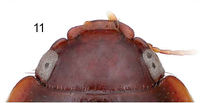Pseudomorpha santacruz
| Pseudomorpha santacruz | |
|---|---|

| |
| Pseudomorpha santacruz | |
| Scientific classification | |
| Kingdom: | Animalia |
| Phylum: | Arthropoda |
| Class: | Insecta |
| Order: | Beetle |
| Suborder: | Adephaga |
| Family: | Carabidae |
| Genus: | Pseudomorpha Kirby, 1825 |
| Species: | P. santacruz |
| Binomial name | |
| Pseudomorpha santacruz Erwin & Amundson, 2013 | |
Diagnosis
Color tone of dorsum rufopiceous, lateral margins of pronotum and elytra rufo-translucent; body robust and rectangulate, lateral margins of elytra slightly tapering to an apically truncated and laterally rounded apex; dorsum mostly glabrous with irregularly and wide-spaced short erect setae; pronotum with lateral margins moderately explanate, about coequal in width to that of elytra across humeri, disc markedly convex and planar; elytral interneurs effaced and not visible under medium magnification, intervals flat; 10 umbilicate setae present near lateral margin, dorsal edge of epipleuron lined with long laterally erect setae.
Description
Size: Medium for genus, ABL = 5.8 mm, SBL = 5.7 mm, TW = 3.5 mm. Preocular lobe-eye ratio: 0.53. Pronotum ratio (L/W): 0.30. Elytron ratio (L/W): 1.4. Color: Dorsum rufopiceous, slightly lighter along explanate edges of pronotum and elytra. Luster:Dorsum dull, slightly matte. Microsculpture: Small isodiametric sculpticells throughout dorsal surface. Head: Genal lobe obsolete, rim posteriad and below eye bearing at least five robust setae directed perpendicular to head; preocular lobe distinct, moderately prominent, and more or less very slightly arcuate (Fig. 11); eye slightly convex, exceeding preocular lobe/gena boundary; clypeus fused to frons with pigmented furrow barely visible, bisetose, setae laterad on margin; labrum with four setae projecting anteriorly (Fig. 11); antennal flagellum markedly setose, antennomeres 1-3 bisetose. Prothorax: Pronotum (Fig. 5) mostly glabrous with irregularly and wide-spaced short erect setae laterally, apex very slightly arcuate medially and narrower than ocular boundary, disk markedly convex and planar except for slightly lower apex, width coequal to that of elytra across humeri, base and apex fringed with more or less evenly spaced setae, median line ending about ¾ before basal margin, lateral margins of pronotum with wide explanate sides, anterior angle 77.36°; prosternal apex fringed with short, evenly spaced setae. Pterothorax: Scutellum visible, moderate sized, narrowly rounded apically; elytra smooth (Fig. 5), interneurs effaced, not visible under low magnification, intervals flat, lateral margin very slightly sinuate at basal third, 10 umbilicate erect setae on the ventrally directed curvature of the elytral lateral portion. Abdomen: All sterna sparsely setiferous, sternum III densely so; male characteristic of species group, see above. Female unknown. Legs: Legs all same castaneous color, tibia setiferous with ring of erect yellow setae on distal end. Male Genitalia: (Fig. 15) Basal orifice hooded by phallobase, orifice recessed and small, phalloshaft arching, shaft narrows toward apex and slightly constricted at apical third, extreme apex acute and slightly bent; parameres co-equal in length, with the left paramere only slightly longer than right, both asetose; apical orifice small, about 1/5 the length of shaft. Female Genitalia: Not investigated.
Holotype. USA, Arizona, Pima County, Santa Rita Mountains, Madera Canyon, 31.724°N, 110.880°W, 1487m, 11 July 1963 (V.L. Vesterby) (UCDC: ADP111870, male). Unique.
Derivation of scientific epithet. The epithet “santacruz” is a singular masculine noun used in apposition and refers to a river in Arizona where the beetles were found. Before the arrival of Spanish, the area was home to the Apache, Yaqui, and Hohokam peoples who built their communities along what are now called the Santa Cruz River and the Sonoita and Harshaw Creeks.
Proposed english vernacular name. Santa Cruz False-form beetle.
Distribution
This species is currently known from Arizona.
Biology
Dispersal potential. These beetles are macropterous and probably fly; they are swift and agile runners. Accordingly, the species may be expected to be more broadly distributed across a wider geographical range than current records indicate.
Way of life. Adults are likely found in ant nests and the surrounding vicinity; females are ovoviviparous (Liebherr and Kavanaugh 1985); larvae are ant nest inquilines (Erwin 1981). Members of Pseudomorpha santacruz occur at midland altitudes near the Sonoran Desert. Adults are active in July, a very hot month in this area.
